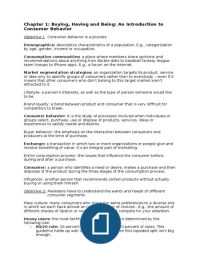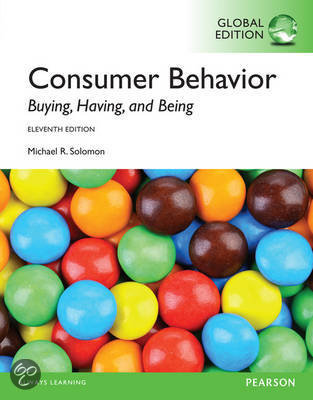Chapter 1: Buying, Having and Being: An Introduction to
Consumer Behavior
Objective 1 Consumer behavior is a process
Demographics: descriptive characteristics of a population. E.g., categorization
by age, gender, income or occupation.
Consumption communities: a place where members share opinions and
recommendations about anything from Barbie dolls to baseball fantasy league
team lineups to iPhone apps. E.g., a forum on the internet.
Market segmentation strategies: an organization targets its product, service
or idea only to specific groups of consumers rather than to everybody – even if it
means that other consumers who don’t belong to this target market aren’t
attracted to it.
Lifestyle: a person’s interests, as well as the type of person someone would like
to be.
Brand loyalty: a bond between product and consumer that is very difficult for
competitors to break.
Consumer behavior: it is the study of processes involved when individuals or
groups select, purchase, use or dispose of products, services, ideas or
experiences to satisfy needs and desires.
Buyer behavior: the emphasis on the interaction between consumers and
producers at the time of purchase.
Exchange: a transaction in which two or more organizations or people give and
receive something of value. It’s an integral part of marketing.
Entire consumption process: the issues that influence the consumer before,
during and after a purchase.
Consumer: a person who identifies a need or desire, makes a purchase and then
disposes of the product during the three stages of the consumption process.
Influencer: another person that recommends certain products without actually
buying or using them himself.
Objective 2: Marketers have to understand the wants and needs of different
consumer segments.
Mass culture: many consumers who share the same preferences to a diverse one
in which we each have almost an infinite number of choices . E.g., the amount of
different shades of lipstick or necktie patterns that compete for your attention.
Heavy users: the most faithful customers. These are determined by the
following rule:
- 80/20 rule: 20 percent of users account for 80 percent of sales. This
guideline holds up well and in some cases even this lopsided split isn’t big
enough.
,Relationship marketing: marketers interact with customers on a regular basis
and give them solid reasons to maintain a bond with the company over time.
Database marketing: tracks specific consumers’ buying habits very closely and
crafts products and messages tailored precisely to people’s wants and needs
based on this information.
Big data: the collection and analysis of extremely large datasets.
Objective 3 Our choices as consumers relate in powerful ways to the rest of our
lives.
Popular culture: the music, movies, sports, books, celebrities and other forms
of entertainment that the mass market produces and consumes.
Role theory: the view that much of consumer behavior resembles actions in a
play. As in a play each consumer has the lines, props and costumes necessary to
put on a good performance.
Some relationships a person might have with a product are:
- Self-concept attachment: the products helps to establish the user’s
identity.
- Nostalgic attachment: the product serves as a link with a past self.
- Interdependence: the product is a part of the user’s daily routine.
- Love: the products elicits emotional bonds of warmth, passion or other strong
emotions.
Objective 4 Our motivations to consume are complex and varied.
One of the fundamental premises of the modern field of consumer behavior:
people often buy products not for what they do but for what they mean.
Brand image: meanings that have been carefully crafted with the help of legions
of rock starts, athletes, slickly produced commercials and many millions of
dollars.
Motivation: the processes that lead people to behave as they do. It occurs when
a need is aroused that the consumer wishes to satisfy. The need creates a state
of tension that drives the consumer to attempt to reduce or eliminate it. This
need may be:
- Utilitarian: a desire to achieve some functional or practical benefit, as when a
person loads up on green vegetables for nutritional reasons.
- Hedonic: an experiential need, involving emotional responses or fantasies.
Motivations are described in terms of its:
- Strength: the pull it exerts on the consumer.
- Direction: the particular way a consumer attempts to reduce it.
Goal: the consumer’s desired end state.
Drive: the urgency the consumer feels to reduce the magnitude of a tension
created by a utilitarian or hedonic need.
, Drive theory: focuses on biological needs that produce unpleasant states of
arousal. E.g., our stomach that grumbles during a morning class. The arousal this
tension causes motivates us to reduce it. Some researchers believe that this need
to reduce arousal is a basic mechanism that governs much of our behavior.
Gratification: the pleasurable emotional reaction of happiness in response to a
fulfillment of a desire or goal.
Expectancy theory: suggests that expectations of achieving desirable
outcomes – positive incentives – rather than being pushed from within motivate
our behavior.
Want: a specific manifestation of a need that personal and cultural factors
determine. E.g., hunger is a basic need that all of us must satisfy; a lack of food
creates a tension state that a person is motivated to reduce. But, the way he or
she chooses to do that can take a lot of forms: one person’s “dream meal” might
include a cheeseburger and fries while another might go for sushi.
Productivity orientation: refers to a continual striving to use time
constructively: trying new things is a way to check them off our “Bucket list” of
experiences we want to achieve before we move on to others.
Some analysts set out to define a universal inventory of needs they could trace
systematically to explain virtually all behavior. A few delineates developed by
Henry Murray are:
- Autonomy: being independent.
- Defendance: defending the self against criticism.
- Play: engaging in pleasurable activities.
Important needs that are relevant that consumer behavior:
- Need for affiliation: to be in the company of other people. The need for
affiliation is relevant to products and services for people in groups, such as
those participating in teams sports, frequenting bars and hanging out at
shopping malls.
- Need for power: to control one’s environment. Many products and services
allow us to feel that we have mastery over our surrounding.
- Need for uniqueness: to assert one’s individual identity. Products satisfy the
need for uniqueness when they pledge to bring out our distinctive qualities.
Hierarchy of needs: a hierarchical structure created by Abraham Maslow that
implies that the order of development is fixed – that is, we must attain a certain
level before we activate a need for the next, higher one. Marketers embraced this
perspective because it (indirectly) specifies certain types of product benefits
people might look for, depending on their stage of mental or spiritual
development or on their economic situation. Figure 1.2 presents this model.





